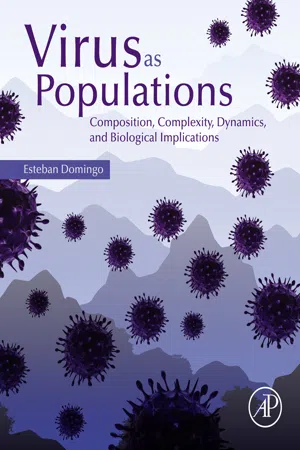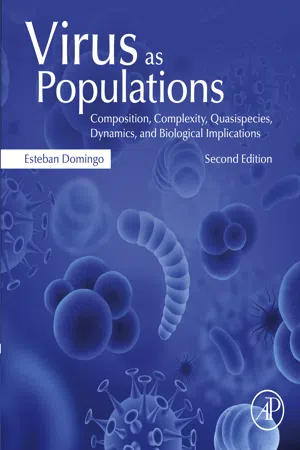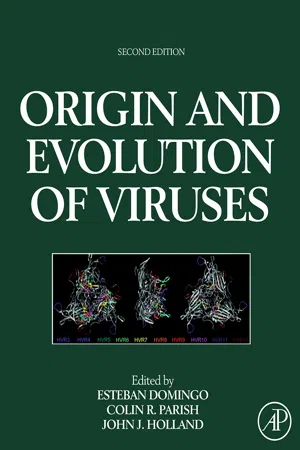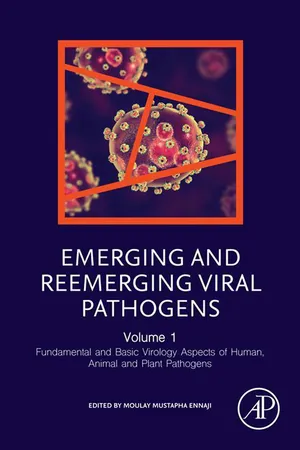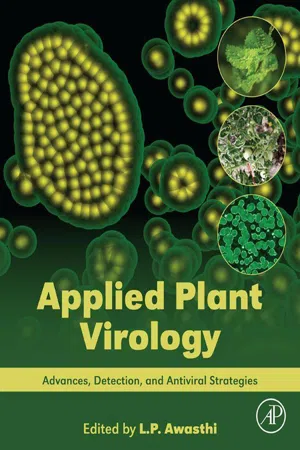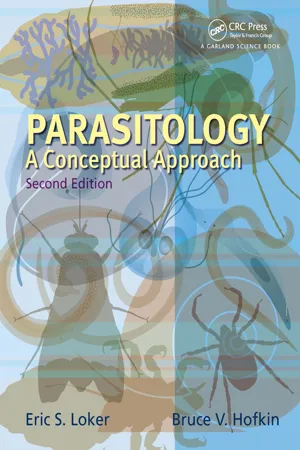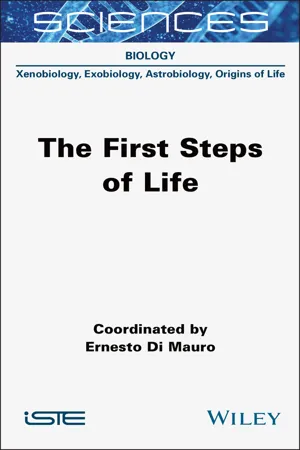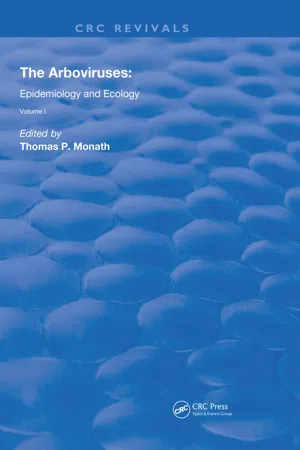Biological Sciences
Evolution of Viruses
The evolution of viruses refers to the process by which viruses change over time through mutation, recombination, and natural selection. This leads to the emergence of new viral strains and species, as well as the adaptation to new hosts and environments. Understanding viral evolution is crucial for developing effective strategies to control and treat viral infections.
Written by Perlego with AI-assistance
Related key terms
10 Key excerpts on "Evolution of Viruses"
- eBook - ePub
Virus as Populations
Composition, Complexity, Dynamics, and Biological Implications
- Esteban Domingo(Author)
- 2015(Publication Date)
- Academic Press(Publisher)
Chapter 7Long-Term Virus Evolution in Nature
Abstract
Viruses spread to give rise to epidemics and pandemics, and some key parameters that include virus and host population numbers determine virus persistence or extinction in nature. Viruses evolve at different rates of evolution depending on the polymerase copying fidelity during genome replication. Calculated rates of evolution in nature vary depending on the time interval between virus isolations. In particular, intra-host evolution is generally more rapid that inter-host evolution and several possible mechanisms for this difference are considered. The mechanisms by which the error-prone viruses evolve render very unlikely the operation of a molecular clock (constant rate of incorporation of mutations in the evolving genomes). Several computational methods are reviewed that permit the alignment of viral sequences and the establishment of phylogenetic relationships among viruses. The evolution of virus in the form of dynamic mutant clouds in each infected individual, together with multiple environmental influences, render the emergence and reemergence of viral pathogens an unpredictable event, another example of biological complexity.Keywords Antigenic diversity Complexity Phylogenetic relationships Rate of evolution Viral disease emergence Virus transmissionChapter Contents7.1Introduction to the Spread of Viruses. Outbreaks, Epidemics, and Pandemics2287.2 Reproductive Ratio as a Predictor of Epidemic Potential. Indeterminacies in Transmission Events - eBook - ePub
Virus as Populations
Composition, Complexity, Quasispecies, Dynamics, and Biological Implications
- Esteban Domingo(Author)
- 2019(Publication Date)
- Academic Press(Publisher)
This book deals with some of these issues, mainly those that are amenable to experimental testing. Topics covered include molecular mechanisms of genetic variation, with emphasis on high mutation rates, Darwinian principles acting on viruses, quasispecies dynamics and its implications, consequences for virus-host interactions, fitness as a relevant parameter, experimental model systems in cell culture, ex-vivo and in vivo, long-term virus evolution, the current situation of antiviral strategies to confront quasispecies swarms, and conceptual extensions of quasispecies to nonviral systems. These subjects have as a common thread that Darwinian natural selection has an immediate imprint on them, observable in the time scale of days or even hours. The capacity for rapid evolution displayed by viruses represents an unprecedented and often underappreciated development in biology: the direct observation of Darwinian principles at play within short times.Evolution is defined as a change in the genetic composition of a population over time. In this book evolution will be used in its broader sense to mean any change in the genetic composition of a virus over time, irrespective of the time frame involved, and the transience of the change. We treat as evolution both the genome variation that poliovirus has undergone from the middle of the 20th century to present days and the changes that the same virus undergoes within an infected individual. It is remarkable that only a few decades ago virus evolution (or for that matter microbial evolution in general) was not considered a significant factor in viral pathogenesis. Evolution was largely overlooked in the planning of strategies for microbial disease control. A lucid historical account of the different perceptions of virus evolution, including early evidence of phenotypic variation of viruses, with emphasis on the impact of the complexity of RNA virus populations, was written by J.J. Holland (2006) - eBook - ePub
- Esteban Domingo, Colin R. Parrish, John J. Holland(Authors)
- 2008(Publication Date)
- Academic Press(Publisher)
et al. , 2006).These two developments would seem reason enough to consider virus evolution in a new light. However, there have also been numerous theoretical proposals suggesting viral involvement in some of the very earliest events and major transitions in the evolution of life. We no longer think of viruses as recent agents that escaped from the host chromosomes as run away replicons. Viruses now appear very old to us and they relate to and trace all branches of life. The last 30 years have been very active regarding virus evolution. Major developments in theory, technology, medicine, and the study of human disease with respect to virus evolution have all occurred. And as we seek to grow and manage various life forms for human use, virus evolution has also had major impact on such efforts.As a science, virus evolution has benefitted greatly from traditional evolutionary biology. However, since viruses are molecular genetic parasites that are inscrutable by casual observation, our understanding of virus evolution has been dependent upon measuring sequence variation and sequence diversity in a large number of virus genomes. Because of this, these small genetic parasites have been the last domain of life to yield their secrets of evolution. And viruses harbor some clearly distinct evolutionary abilities. For one, they are polyphyletic. All major viral lineages have their own distinct origins. They are also difficult if not impossible to define as species and are able to exchange genetic information across normal boundaries. Even “dead” and defective viruses can participate in such exchanges, which confuses the definitions of fitness. We now know that viruses can evolve by a consortia process and also exchange information by recombination across vast genetic pools to assemble new mosaic combinations of genes. We thus no longer think of a specific genetic lineage in understanding virus evolution, but instead think of a cloud, matrix, or a population as the basis of virus evolution. Viruses are inherently fuzzy entities that can differ from their relatives in any specific feature. Yet even with such fuzziness, it is clear that common themes also link them. Patterns of evolution have become clear. Diversity and variation are often (but not always) observed. Stability and host congruence can also be observed. Nevertheless, the evolutionary power of viruses has been learned at a human cost. - eBook - ePub
Emerging and Reemerging Viral Pathogens
Volume 1: Fundamental and Basic Virology Aspects of Human, Animal and Plant Pathogens
- Moulay Mustapha Ennaji(Author)
- 2019(Publication Date)
- Academic Press(Publisher)
Chapter 3Viral Emerging Pathogen Evolution
Virginia Rodríguez1 , 2 , Alfredo Lagares2 , 3 , Heiser Arteaga2 , 4 , Salim Mattar5 and Luis Carlos Ruiz2 ,1 Microbiological and Biomedical Research Group of Córdoba, University of Cordoba, Monteria, Colombia, South America,2 Tropical Health and Microbiology Program, Universidad de Córdoba, Córdoba, Colombia,3 Group of Immunology and Molecular Biology University of the Atlantic, Barranquilla, Colombia,4 Faculty of Health Sciences, Department of Basic Health Sciences, Universidad del Sinú, Monteria, Córdoba, Colombia,5 Institute of Biological Research of the Trópico, University of Córdoba, Faculty of Veterinary Medicine, Córdoba, ColombiaAbstract
The emergence of emerging and reemerging infectious diseases throughout history has been the product of the interaction of infectious agents, immunity, selective pressure, and environmental factors. The origin of the viral ancestors remains controversial, the debate remains whether the viruses existed before their host cells, evolved as molecular structures that adapted to the intracellular development or of the cells that infected or housed them as hosts. The nature of the viruses could propose a hypothetical evolutionary model based on the way they parasitize cells and the way they fuse with their host cells. So far there are no “universal” viral genes that have not allowed the hypotheses of the “common viral ancestor” to be conclusive. Insects have a special role in understanding viral evolution and how they became pathogens, suggesting a coevolutionary scenario of colonization that would initially allow the survival of viruses and later an ecological niche required for the cycle of virus replication. The coEvolution of Viruses and defense systems of hosts represents a fundamental role in the evolution of both viruses and host cells, a kind of arms race between viruses and hosts, and the deescalation of that war could explain the coexistence of viruses and hosts. Viruses are playing an important role in the understanding of cell evolution and have earned the right to be included in the tree of life. The aim of this chapter is to review the viral evolution and the insects as host. - eBook - ePub
Applied Plant Virology
Advances, Detection, and Antiviral Strategies
- L. P. Awasthi(Author)
- 2020(Publication Date)
- Academic Press(Publisher)
The diversity within plant virus populations that drives evolution in an intensive agro-ecosystem is a growing concern, as this results into frequent outbreak of disease in the different geographical parts of the world causing huge economic loss. The evolutionary events always lead to genomic variations in the virus population and the emergence of new strains. Their modified pathogenicity and host range help to cope with the natural selection pressure, which works in favor of new variants to adapt to the new host population. This is followed by a tremendous increase in its population size in relation to the host population. Among many phytopathogens, viruses are highly evolved owing to their simple genome structure, complex mode of infection, and higher mutation rates. Their evolution is a continuous process that is evident from the increasing incidence of virus outbreaks in new crop varieties and new regions. The emergence of infectious virus diseases has been partly linked to agricultural practices and climate change. In this chapter, we will focus on the different hypotheses of origin of virus and with relation to this, we describe the distinct evolutionary dynamics of plant viruses.54.2 Virus origin hypothesis
There is a long-standing debate among biologists about the origin and Evolution of Viruses. Being acellular, viruses are rarely considered to be in the same evolutionary category as other cellular organisms. Thus, different hypotheses have been postulated to resolve this issue, but each has its own merits and demerits. Initially, hypotheses are formulated based on the assumption of the cell-first model (i.e., cells existed before viruses) and the progressive and regressive hypothesis was suggested to address the evolutionary aspects of viruses. The strict parasitic dependence of viruses on their hosts makes these hypotheses more prominent.54.2.1 Cell-first model
54.2.1.1 Degenerative hypothesis
During the early 20th century, when the discovery of viruses was in progress and they were included within the framework of microbiological principles, their origin was thought to be centered on the “degenerative” or “regressive” evolution theory. This regressive or reduction hypothesis states that the existing viruses evolved from more complex, possibly free-living cellular organisms (independent life forms) over time through a loss of essential functional genes (Fig. 54.1 ). Eventually, it was unable to replicate independently and adopted an obligate parasitic lifestyle for multiplication. One can exemplify the origin of nucleocytoplasmic large DNA viruses, such as Mimivirus and Megaviruses , from more complex cellular ancestors (bacteria or Rickettsia ) through a reductive process, with the supportive evidence of the presence of a large number of enzymes like various hydrolases, proteases, kinases, phosphatases, and many others that are essential for metabolic processes (Durzyńska and Goździcka-Józefiak, 2015 - eBook - ePub
Principles of Virology, Volume 2
Pathogenesis and Control
- S. Jane Flint, Vincent R. Racaniello, Glenn F. Rall, Theodora Hatziioannou, Anna Marie Skalka(Authors)
- 2020(Publication Date)
- ASM Press(Publisher)
The word “evolution” conjures up images of fossils, dusty rocks, and ancestral phylogenetic trees, covering eons. Thanks to the recent development of rapid sequencing methods, we can now discover fossils of ancient viruses, not in rocks, but in the DNA of living organisms. For currently circulating viruses, evolution is not only contemporary (and rapid), but also has profound effects on both viruses and their hosts: as host populations change or become resistant to infection, viruses that can overcome such changes are selected. Viral infections can also exert significant selective forces on the survival and evolution of host populations. In some ways, viral evolution can be thought of as the product of a continuing arms race in which both viral and host cell genes are selected in response to the pressures encountered during infection.How Do Virus Populations Evolve?
A large, genetically variable host population dispersed in everchanging environments may appear to present insurmountable barriers to the survival of viruses, yet viruses are plentiful and ubiquitous. The primary reason for this remarkable success is that virus populations display spectacular genetic diversity, manifested in the large collections of genome permutations that are present in a population at any given time. The sources of such diversity are mutation, recombination, and reassortment of viral genes.is driven by selective pressure acting on diversity that promotes survival of genomes with the most advantageous properties.Virus evolutionIn most viral infections, hundreds to thousands of progeny particles are produced after a single cycle of reproduction in one cell. When genome copying is error-prone, almost every new virus particle can differ from every other. Consequently, it is misleading to think of an individual particle as representing an average for that population. This great diversity in the virus population provides avenues for survival under varying conditions. Every individual virion is a potential winner, and occasionally, the rarest genotype in a particular population will be the most common after a single selective event.Positive and negative selection of preexisting genotypes in a population can occur at any step in a viral life cycle. The requirement to spread within an infected host, as well as between hosts, exposes virus particles to a variety of host antiviral defenses. In addition, the density of host populations, their social behavior, and their health represent but a few of the other forces that can affect the survival of virus populations. - eBook - ePub
Viruses
Molecular Biology, Host Interactions, and Applications to Biotechnology
- Paula Tennant, Gustavo Fermin, Jerome E. Foster(Authors)
- 2018(Publication Date)
- Academic Press(Publisher)
It is true that, thanks to the dedicated efforts of virologists and the advancement of new and powerful technologies, viruses unheard of before are being discovered almost on a daily basis. And they catch our attention for a good reason: they are fascinating. For one thing, they are challenging our previous paradigms regarding their nature and origin; additionally, they exert varying effects on all living organisms, communities, and the biosphere as well. No one can claim for sure that they have discovered an “emerging” virus if we accept the idea that all living beings are in continuous change (biological evolution) and thus continuously “emerging” with renovated faces. All viruses have ancestors that somehow, in some time in history, appeared and later changed to the forms (and with the capabilities) we now know. How this happened is probably one of the most crucial questions of biology due to the likely impact on our comprehension of the phenomenon we call life. So far we have presented on the structure and composition of viruses, and we will present later on the species they interact with, and the many consequences these relationships have on the hosts, the viruses themselves and the environment where both reside. In this chapter the focus is on the origin and Evolution of Viruses. In studying the evolutionary history of viruses, we cannot rely on the discovery and analysis of material that have helped us greatly in the study of some cellular organisms: fossils and/or sequences of shared genes (for instance, ribosomal genes), or a gene common to all members of a particular group (chloroplast genes in plants, for example). With viruses this is not possible. There is not a single gene shared among all viruses - eBook - ePub
Parasitology
A Conceptual Approach
- Eric S. Loker, Bruce V. Hofkin(Authors)
- 2022(Publication Date)
- CRC Press(Publisher)
Chapter 6 , with its discussion of the ecology of parasitism, sets the stage to launch a deliberation of the evolutionary biology of parasites. Ecology has been likened to the theater in which the evolutionary play unfolds. The fundamental forces of evolution—mutation, genetic drift, gene flow and natural selection—apply just as inexorably and in fundamentally the same ways to parasites as they do to other organisms. However, as we shall see, the dependence of parasites on their hosts, the selection imposed by the host, and the constant need to be transmitted to new hosts, all create distinctive features in parasite evolutionary biology. As often noted elsewhere in this book, we must remember the term “parasite” embraces an enormous variety of organisms with different phylogenetic backgrounds, bodies of different size or complexity, life cycles that range from simple to complex, generalized or specific patterns of host use, and different modes of reproduction. Furthermore, the hosts occupied differ enormously in properties such as mobility, longevity, immune capability and spatial and temporal distributions, all features that directly influence the evolutionary biology of the parasites they harbor. Consequently, it is hardly surprising that collectively, parasites exhibit a huge range of evolutionary trajectories, making grand generalizations about parasite evolutionary biology elusive.We will first examine parasites from the perspective of microevolution . This refers to the evolutionary process as it occurs below the species level, particularly at the level of populations within a species, with an implied ecological time scale. This means that microevolutionary changes can often be seen within the span of a few generations. We consider the topics of parasite–host coevolution and the evolution of virulence as examples of dynamic microevolutionary processes occurring on ecological time scales. Next, we discuss macroevolution - eBook - ePub
- Ernesto Di Mauro(Author)
- 2023(Publication Date)
- Wiley-ISTE(Publisher)
Are viruses alive? Probably not, because they can only reproduce in living cells. Viruses seem to exist somewhere between the living and nonliving, just as the earliest stage of life was a transition from random mixtures of organic material to nonrandom systems of organic compounds that exhibit the properties of life: metabolism, growth by polymerization and reproduction. It is reasonable to think that viruses have always existed in parallel with living cells. The novel coronavirus, SARS-CoV-2, is just one tiny branch of an evolutionary tree that goes back in time at least 4 billion years and may even have been involved in the origin of life.5.2. Viral diversity
As the concept of viruses slowly penetrated the scientific community, research diverged into three paths defined by the kinds of cells that were infected. Two of the hosts – plants and animals – were obvious because of the diseases that the viruses caused. The filtration test devised by Ivanovsky became an important way to exclude bacteria as the causative agent of diseases. For instance, the infectious agent of foot and mouth disease in cattle passed this test and was the first animal virus reported in 1897, followed closely by the yellow fever virus in 1900 (Reed 1902). The third path was less obvious because the host cells are microscopic bacteria. We now know that an invisible battle is being waged continuously between bacteria and the viruses that infect them. The first hint was reported in 1896 by Ernest Hankin who made the surprising observation that an invisible agent in river water from the Ganges in India could destroy the bacteria responsible for cholera (Hankin 1896). Ten years later, Felix d’Herelle observed something that killed dysentery bacteria growing in Petri dishes. d’Herelle (1917, 1931) realized that this was a virus and invented the word bacteriophage1 , derived from Greek words for “bacteria eater”.Viral diversity is immense (Figure 5.1 - eBook - ePub
The Arboviruses:
Epidemiology and Ecology
- Thomas Monath(Author)
- 2020(Publication Date)
- CRC Press(Publisher)
Chapter 3Virus Variation and Evolution: Mechanisms and Epidemiological Significance
Barry J. Beaty, Dennis W. Trent and John T. Roehrig TABLE OF CONTENTS-
Introduction
-
Mechanisms for Generation of Genetic Diversity
-
Evolutionary Mechanisms for Arboviruses with Nonsegmented Genomes
-
General Considerations
-
Variation in Alphaviruses and Flaviviruses
-
-
Evolutionary Mechanisms for Arboviruses with Segmented Genomes
-
Intramolecular Changes
-
Segment Reassortment
-
Reassortment of Arboviruses in Vitro
-
Reassortment of Arboviruses in Nature
-
-
-
-
Site of Virus Evolution
-
Virus Evolution in the Vertebrate
-
Nonsegmented Genome Viruses
-
Segmented Genome Viruses
-
-
Virus Evolution in the Vector
-
Virus Reassortment in Vectors
-
Interference to Superinfection in Vectors
-
Superinfection of Transovarially or Transstadially Infected Vectors
-
Summary of Mechanisms for Generation of Genetic Diversity in Arthropods
-
-
-
The Immune Response and Determination of Arbovirus Phenotypes
-
Selection of Antigenic Variants by Neutralizing Antibody
-
Selection of Variants by Antibody-Complement Mediated Mechanisms
-
Selection of Antigenic Variants by Virus-Specific Cytotoxic T-Cells
-
Selection of Variants by Antibody-Mediated Enhancement of Virus Growth
-
Summary of Immune Mechanisms in Antigenic Variability of Arboviruses
-
-
Epidemiologic Significance
-
References
I. Introduction
The unifying feature of arbovirus biology is the development of complex arthropod-vertebrate virus transmission/maintenance cycles. In such cycles, virus genetic information must be successfully expressed in two phylogenetically unrelated biological systems. It is remarkable that viruses as diverse in physicochemical and morphogenetic properties as the togaviruses, flaviviruses, bunyaviruses, orbiviruses, and rhabdoviruses have evolved transmission cycles which involve continuous bidirectional bridging of the phylogenetic gap separating vertebrate from invertebrate.1
Index pages curate the most relevant extracts from our library of academic textbooks. They’ve been created using an in-house natural language model (NLM), each adding context and meaning to key research topics.
